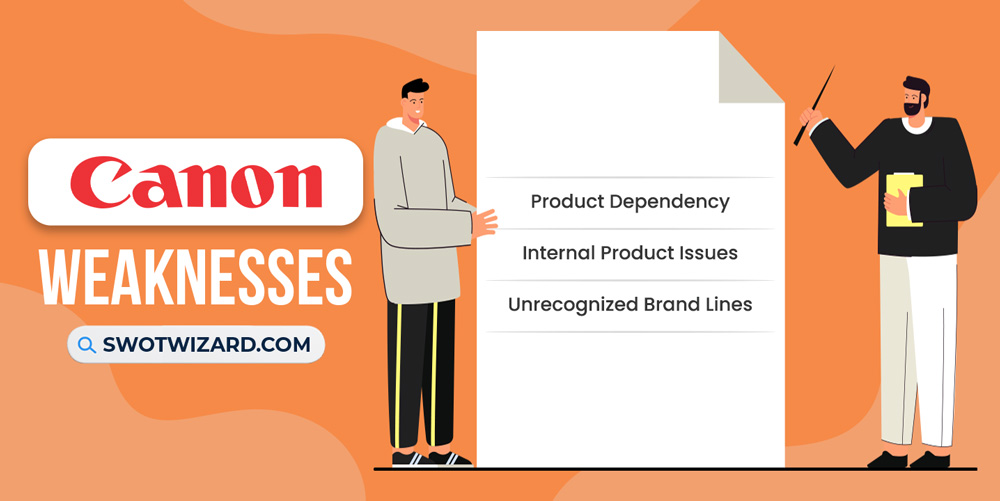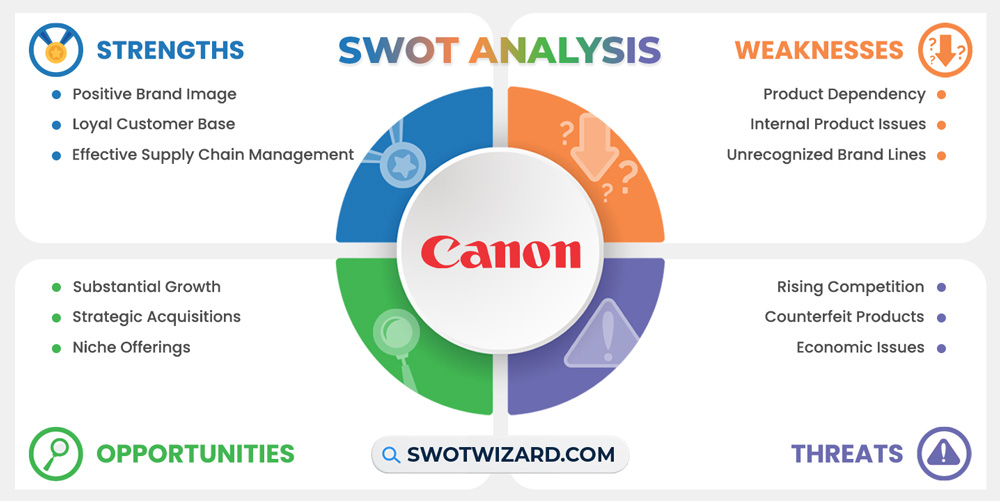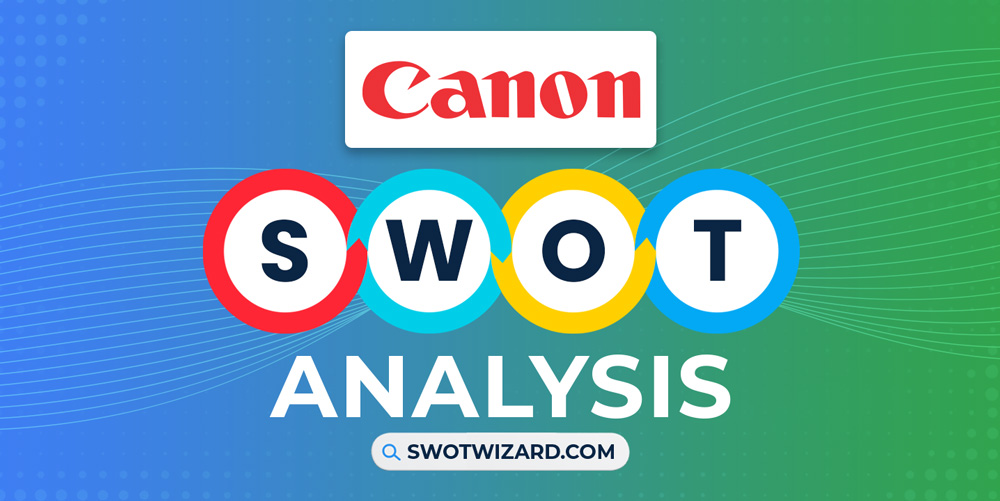Canon cameras have been used in every country of the world by professional photographers, journalists, tourists, and many more, whether for collecting memories or for newspapers. And it’s going to capture billions of images in the coming days, and we will get to know about this company in this Canon SWOT analysis.
Canon: Company Overview
| Company | Canon Inc. |
| Industry | Electronics |
| Founded | 10 August, 1937 |
| Founder | Goro Yoshida, Saburo Uchida, Takeo Maeda |
| CEO | Fujio Mitarai |
| Headquarter | Shimomaruko, Ōta, Tokyo, Japan |
| No. of Employees | 184,034+ |
| Annual Revenue | ¥4.03 trillion (FY 2022) |
| Website | global.canon |
Canon’s first camera was named “Kwanon,” inspired by the Buddhist goddess of mercy. The camera was produced in prototype form in 1934, marking Canon’s entry into the camera industry even though the company was officially founded in 1937 by Takeshi Mitarai, Goro Yoshida, Saburo Uchida, and Takeo Maeda.
Over 80 years have passed, and now Canon has a global footprint spanning 370 companies and maintains large operations in the Americas, Europe, and Asia with over 180,000 employees worldwide. Canon develops and manufactures a variety of imaging and optical products, including printers, cameras, lenses, and medical equipment, earning over $31.042B in gross revenue in 2022.
Product & Services of Canon
Cameras | Photocopiers | Camcorders | Printers | Scanners | Binoculars | Lenses | LCDs
Canon Competitors
Nikon | Casio | Samsung | Sony | HP | Panasonic | Fujifilm | Olympus | Kodak
Did You Know?
In 1984, Canon’s RC-701 was used as the first-ever digital still camera in space aboard the Space Shuttle Discovery.
Strengths – Canon SWOT Analysis

Positive Brand Image: The company has cultivated a powerful global brand over the past 80 years, currently ranked among the top 100 companies in Interbrand’s Best Global Brands report. The brand value stems from a reputation for quality, reliability, and innovation across its product lines. According to some surveys, the brand has segment-leading over 79% repurchase intent among EOS camera owners.
Loyal Customer Base: As an early pioneer in digital cameras and office equipment, the brand has secured immense customer loyalty over decades of operation. According to data, Canon has over 130M active Inkjet printer users that utilize recurring supplies and services, and there could be more real users.
Effective Supply Chain Management: The brand was able to maintain an efficient, just-in-time principle, and it operates an effective, integrated supply chain from component manufacturing to inventory management. As a result, it has enabled over 30 Canon plants globally, ensuring minimized costs and consistent quality control.
Weaknesses – Canon SWOT Analysis

Product Dependency: Canon camera sales rely heavily on demand for complementary products like lenses and flashes, allowing competitors to undermine sales efforts. If we look at past sales histories, when Sigma and Tamron released feature-rich, lower-cost lenses in the last few years, the company noted a resultant 6% dip in camera revenues due to switch brand compatibility.
Internal Product Issues: Product defects and large-scale recalls in major Canon product lines have impacted brand perception and incurred significant costs in recent years. A few years ago, Canon printer security flaws and toner issues triggered a $6.8M product recall covering over 120,000 units, not to mention The 2017 sensor malfunction in specific models affected image quality, leading to recalls and tarnishing the brand’s reputation.
Unrecognized Brand Lines: The company’s weaker branding in specific non-core product segments dampens public awareness and adoption levels. As a result, Canon is underrepresented in the $7.4B security camera market due to limited brand recognition, claiming just around 3% market share against leaders Hikvision and Dahua.
Opportunities – Canon SWOT Analysis

Substantial Growth: As an established imaging leader, Canon is distinctly positioned to capitalize on the forecasted growth in mirrorless cameras. The market is predicted to show a considerable percentage of CAGR from 2022-2027 as adoption accelerates, signaling a $5-10B revenue opportunity for Canon as an early mover.
Strategic Acquisitions: The company’s strong balance sheet and $2.42B annual R&D budget afford acquisition opportunities to advance product portfolios rapidly. Canon could enhance imaging software, printer hardware, or medical device offerings through purchases of innovative startups at reasonable valuations, as it purchased Océ, a leader in printing technology.
Niche Offerings: Specialized industrial and scientific imaging products offer sustained growth potential despite representing just a small portion of current revenues. Besides, the success of the Cinema EOS line, offering high-quality cinematic capabilities, reflects the potential for niche products in targeted segments, ensuring sustained growth and customer loyalty.
Threats – Canon SWOT Analysis

Rising Competition: The company is continuously facing mounting competitive pressure in its core camera market from brands like Sony and Nikon, evidenced by declining market share from 50% in 2012 to around 36% in 2022. Besides, in some segments, Sony surpassed Canon in global mirrorless camera sales by capturing a 29% market share compared to Canon’s 26%.
Counterfeit Products: The counterfeiting of profitable Canon printer consumables results in an estimated loss of over $90M in annual revenues, not to mention that those poorly made fakes or products tarnish the brand’s reputation. Recent seizures in the EU and Africa highlight the complex transnational scale Canon must combat.
Economic Issues: As the world is moving faster than ever, trends like industrial automation and the decline of office printing have driven year-over-year declines in Canon’s Office Business Unit since 2018, impacting overall profit margins. Not to mention, Covid, recent inflation, and other issues have been significantly impacting consumers’ overall purchasing power.
[Bonus Infographic] SWOT Analysis of Canon

Recommendations for Canon
Here are some recommendations for Canon:
- Accelerate mirrorless camera development and technology to defend market share against Sony and Nikon.
- Pursue acquisitions for enhanced software, analytics, and service capabilities to complement Canon’s robust hardware offerings.
- Seek alliances with leading accessory, component, and solution providers to underscore commitment.
- The company should leverage technology like blockchain to track and authenticate products, ensuring customers receive genuine items and stop counterfeiting.
Frequently Asked Questions (FAQs)
Is Canon Made in China?
No, Canon is not Made in China.
Who is the CEO of Canon?
Fujio Mitarai is the CEO of Canon.
Final Words on Canon SWOT Analysis
Canon enjoys distinct strengths from its brand equity, customer loyalty, and supply chain efficiency that have fueled substantial profitability but face rising competitive threats, counterfeiting issues, and economic vulnerability in crucial markets. Effectively competing in mirrorless cameras and adjacent growth areas via updated product development and strategic M&A represent critical opportunities, while diversification and partnerships should mitigate external risks.
References
- Wikipedia contributors. (n.d.). Canon. Wikipedia.




